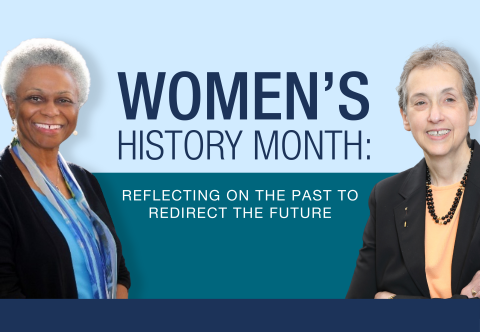
Marie A. Bernard, M.D. and Dr. Nina Schor, NIH Deputy Director for Intramural Research. Credit: NIH
As we celebrate Women’s History Month, we can be motivated by many pioneers in health, medicine, and science.
Consider the bravery of Susie King Taylor (1848—1912), a Black nurse who cared for soldiers during the Civil War. In her book Reminiscences of My Life in Camp, she wrote, “It seems strange how our aversion to seeing suffering is overcome in war … and instead of turning away, how we hurry to assist in alleviating their pain, bind up their wounds, and press cool water to their parched lips, with feelings only of sympathy and pity.”
At a time when Native Americans weren’t regarded as citizens and couldn’t vote, Dr. Susan La Flesche Picotte (1865-1915) became the first Native American to graduate from medical school. And there’s Mary McLeod Bethune (1875-1955) who despite her many disadvantages growing up during the Reconstruction Era left an enduring legacy that includes establishing a school, which today is Bethune Cookman University with schools that include nursing and health sciences. She was also the first woman and African American to be honored with a statue on public land in Washington, DC.
This month is also a good time to reflect on the life of Virginia Apgar (1909-1974). If you had a baby or were a baby born in the past 40 years or so, chances are you were given a health score at birth, which was named after her.
Taylor, Picotte, Bethune, and Apgar are just a few examples of ground-breaking female leaders from the last two centuries.
Trailblazing to Today
As much as I’m inspired by these and other trailblazers, I’m equally invigorated by women making history today—here at NIH. For the first time in NIH’s history, women comprise 41% of our institute and center directors.
As I reflected on this progress at NIH, I reached out to my friend and colleague NIH Deputy Director for Intramural Research Nina Schor for her thoughts on women leaders and diversity in science.
Dr. Schor and I are both part of a group that she describes as “a generation that includes many women who were driven away from science and medicine in anger and frustration, carrying posttraumatic stress and loneliness with them.” Recognizing the obstacles that so many of us faced, we’re both passionate about working toward a time when more women and more people with diverse backgrounds have their rightful place in leadership.
I found Dr. Schor’s observations to be insightful—and I hope you do, too.
Leadership, Vision, and Stereotypes
When asked what difference it makes having more women in leadership roles in science and at NIH, Dr. Schor responded, “I think having women in leadership makes a difference in at least two ways. The most obvious is that girls and young women seeing women in such roles makes it more likely they will see themselves playing leadership roles in STEMM. Second, both biology and experience shape one’s approaches to and vision for leadership.”
Addressing society’s stereotype of women as “nurturers and disciplinarians,” Dr. Schor explained how although this is sometimes seen as negative, there’s a positive side. “It is a strength that women leverage instinctively to ensure that those we mentor and those for whom we are role models are trained, guided, and constructively critiqued in one-on-one mentoring settings and encouraged, sponsored, and championed in more public settings.”
Feeling Part of a Community
Regarding the Distinguished Scholars Program, which recruits investigators from diverse backgrounds and provides them with mentoring and other professional development activities, Dr. Schor offered some helpful insights.
“Diversity of viewpoints, experiences, approaches, and outlooks enriches everyone, but it isn’t enough to have a diverse group of scholars and scientists at NIH,” she explained. “They must feel part of a community among themselves and part of a larger community among all the scholars, scientists, and staff. Only with the synergies that these afford will they feel supported, appreciated, and impactful in making a broad and deep landscape out of the patchwork quilt that is sometimes the reality at NIH.”
Both Dr. Schor and I place a great deal of importance on mentorship. “I have learned so much from the ‘league of nations’ that is my cadre of former and current mentees,” she said. “Recently, I have seen compassion and colleagueship, understanding and willingness to talk about sensitive issues in ways I had never seen them before.”
Timeless Advice
When I asked Dr. Schor about her advice for future leaders in science, she said, “Change is not easy to take or to make. If it comes too quickly, it is often not durable and may come at the expense of the change agent.” She also shared these timeless words of wisdom: “Learn to listen at least as much as you talk.”
In my experience, listening is key to success. Each of us brings our personalities, professional expertise, and personal experiences to our positions. The more we learn from each other, the stronger we all will be. History—and “herstory” —will benefit.
Note: For more insights from Dr. Schor, please check out her piece in JAMA Neurology (Schor, NF. Toward a Smoother Rocky Road. JAMA Neurol. 2020; 77(12):1481. doi: 10.1001/jamaneurol.2020.3622).

